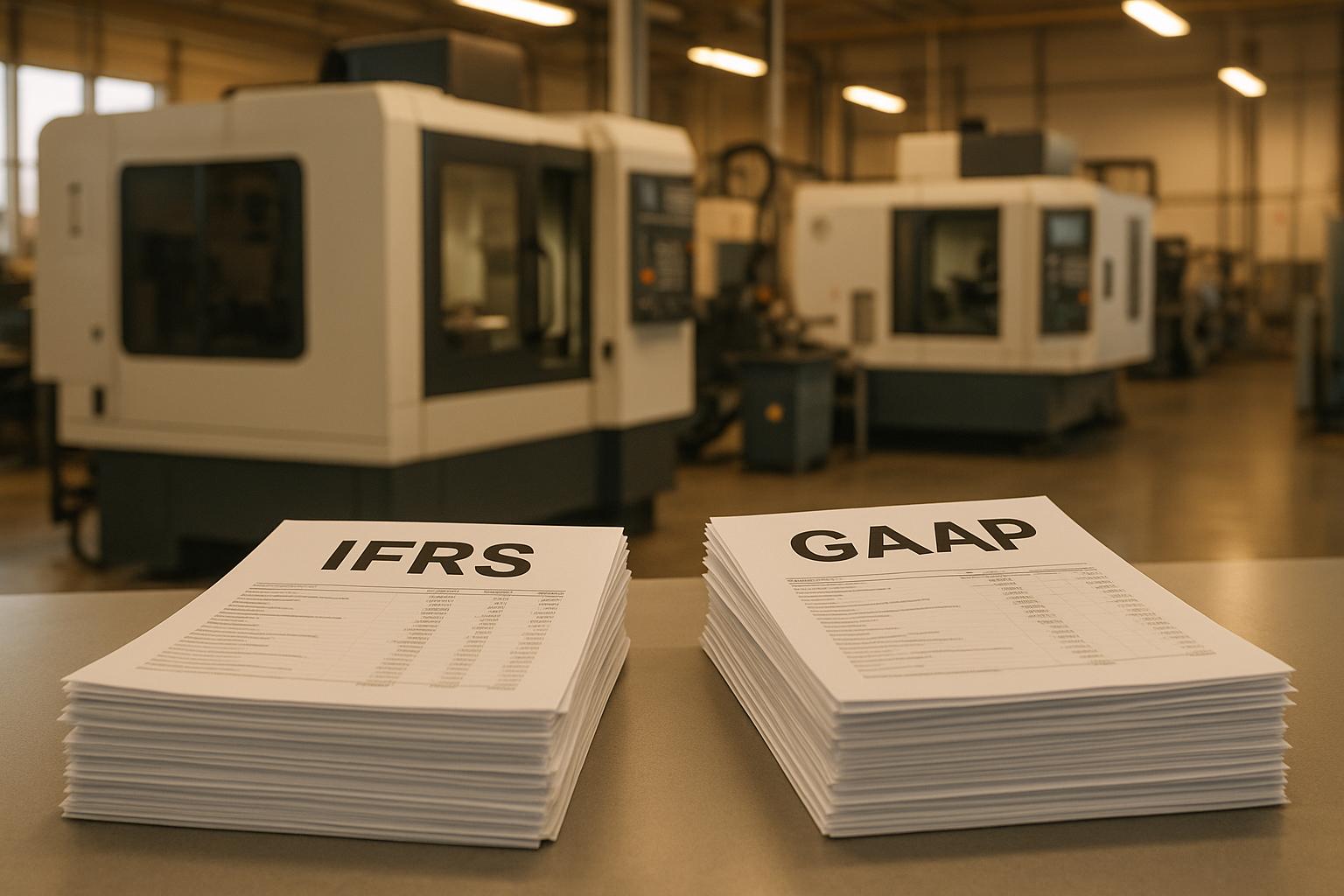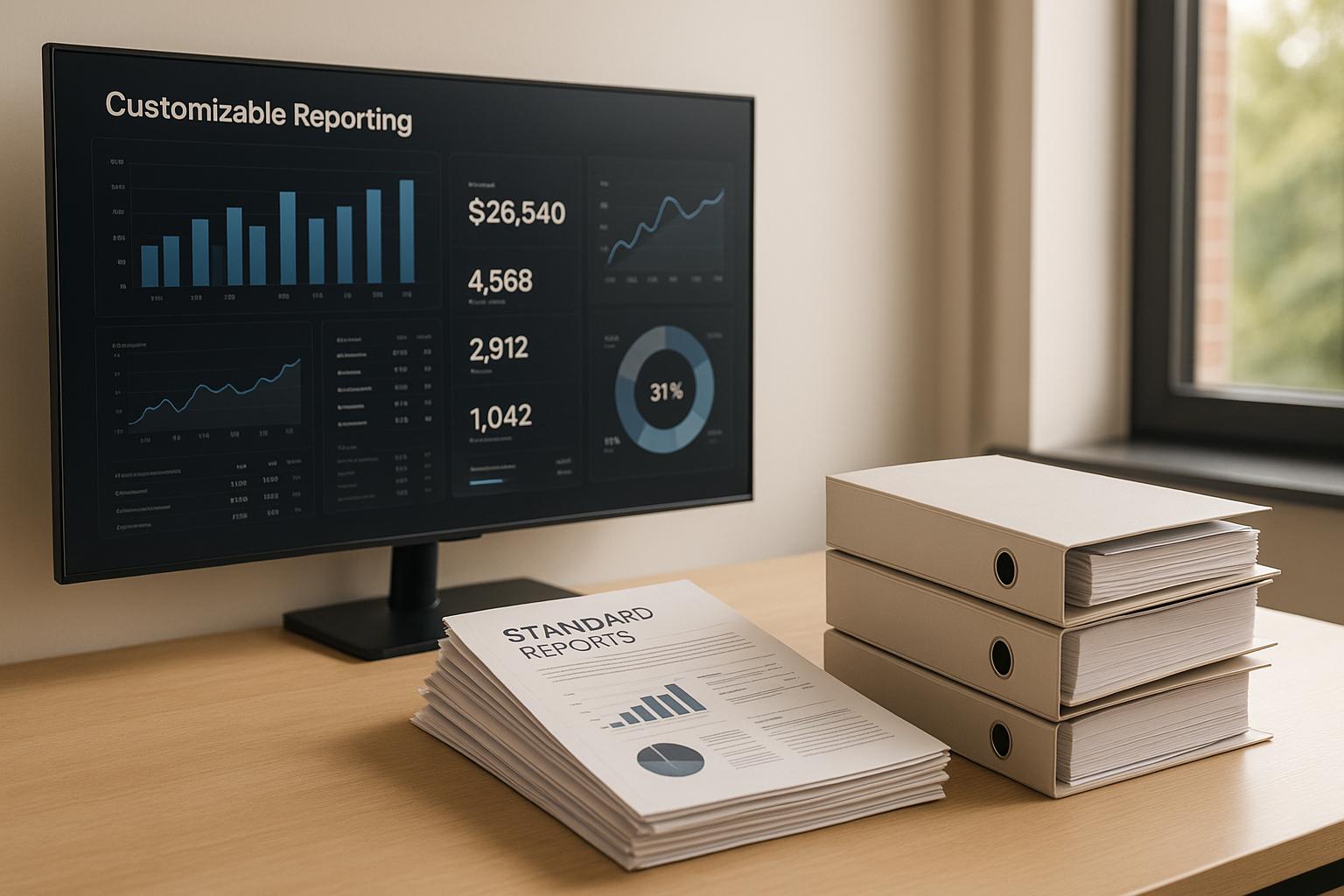IFRS vs GAAP: Depreciation Impact on Manufacturing

IFRS and GAAP handle depreciation differently, impacting how manufacturers report asset values and profits. Here's the key takeaway: IFRS emphasizes precision with component-based depreciation and asset revaluations, while GAAP prioritizes simplicity using historical cost and consistent methods. These differences shape financial decisions, tax strategies, and international compliance efforts.
Key Differences:
- IFRS: Requires separate depreciation for asset components, annual reviews, and allows revaluations to fair value.
- GAAP: Focuses on single-asset depreciation, limited reviews, and prohibits revaluations.
Why It Matters:
- Manufacturers with global operations face challenges managing dual reporting under both frameworks.
- IFRS’s flexibility may better reflect market conditions but increases complexity.
- GAAP’s consistency simplifies processes but may undervalue assets over time.
Understanding these frameworks is critical for choosing the right approach, especially for companies navigating international markets or planning significant investments.
How IFRS Handles Depreciation
Under IFRS, companies are required to separately depreciate significant components of equipment. This component-based depreciation is a key difference from US GAAP, which allows but does not mandate this practice. For manufacturers with complex, high-value assets, this method offers a more precise way to match depreciation with how the asset's value is consumed over time.
Component-Based Depreciation Method
IFRS requires companies to identify and depreciate parts of an asset separately if they have differing useful lives or depreciation patterns. For instance, imagine a ship purchased for $400,000 with a 15-year lifespan. It might be divided into components such as the dry-docking, the body, and the engines - each depreciated according to its specific life span. While this method ensures greater accuracy, it also demands updates to asset records and capital management processes.
Annual Reviews of Depreciation Assumptions
IFRS also emphasizes the importance of annual reviews for depreciation assumptions. Under IAS 16, companies must reassess the useful lives, residual values, and depreciation methods of their assets to ensure they align with current market and operational realities. This regular evaluation helps prevent accounting errors that could distort net income or impact tax compliance and long-term planning. When changes are identified, IFRS requires these adjustments to be applied prospectively, not retroactively. For assets with significant or volatile changes in fair value, more frequent reviews may be necessary.
Revaluation of Assets
One of the standout features of IFRS is the option to revalue property, plant, and equipment to their fair value, instead of sticking to the historical cost model used under US GAAP. If a company opts for this revaluation model, it must regularly assess whether the carrying amount of the asset reflects its fair value at the reporting date. This can uncover hidden value, particularly in cases where older assets have gained from market shifts or technological advancements. By providing a more current view of asset values, revaluations can play a critical role in guiding strategic decisions like investments or divestitures.
"The revaluation model provides several benefits. Enhanced transparency and relevance are achieved as the model provides a more accurate and current reflection of an asset's value, enhancing the relevance of financial statements for investors and other stakeholders." - Ricardo Aldana, Candidate to CPA Ontario
How US GAAP Handles Depreciation
Unlike IFRS, US GAAP takes a more straightforward approach, focusing on consistency and simplicity rather than tracking every individual component of an asset. This makes it easier for manufacturers to apply, but it also means less flexibility when it comes to valuing and reviewing assets over time.
Single Asset Depreciation Method
US GAAP simplifies asset depreciation by allowing companies to treat entire assets as a single unit. For example, manufacturers can depreciate a complex piece of equipment - like an industrial printing press or an assembly line - as one entity, rather than breaking it down into components, as IFRS requires.
Manufacturers can choose from several depreciation methods under US GAAP, depending on their needs:
- Straight-line method: The most commonly used method because of its simplicity. It spreads the depreciation evenly over the asset’s useful life. For instance, a machine costing $10,000 with a 5-year life and a $2,000 salvage value would result in annual depreciation of ($10,000 - $2,000) ÷ 5 = $1,600.
- Accelerated depreciation methods: These, like the declining balance method, allow for higher depreciation expenses in the earlier years. For example, a $10,000 machine with a 40% depreciation rate would record $4,000 in depreciation in the first year.
- Units of production method: This approach ties depreciation directly to usage, making it ideal for equipment whose value depends on output.
Limited Review Requirements
One key feature of US GAAP is its limited review requirements for depreciation. Companies only need to reassess depreciation schedules if there’s evidence of impairment. This means manufacturers can stick to their original assumptions for years, even if economic conditions change.
While this approach provides consistency, it can lead to outdated asset values on the books. For example, if new technology makes a piece of machinery obsolete sooner than expected, US GAAP doesn’t require annual updates to depreciation assumptions. This could delay the recognition of impairment losses, potentially overstating asset values in financial statements. This conservative practice highlights a major difference between US GAAP and IFRS in how assets are valued.
No Asset Revaluation Allowed
US GAAP also prohibits revaluing long-lived assets to reflect their current market value, even if their worth has increased significantly. Unlike IFRS, which allows companies to adjust property, plant, and equipment to fair value, US GAAP mandates that assets remain recorded at their historical cost.
For instance, a manufacturing plant purchased 20 years ago in a now highly desirable industrial area would still be listed at its depreciated historical cost under US GAAP, even if its market value has skyrocketed. While this approach ensures consistency and reduces the risk of manipulation, it prevents manufacturers from showing the full economic value of their assets to investors, lenders, and other stakeholders.
Main Differences and Manufacturing Impact
After diving into how IFRS and GAAP handle depreciation, it’s time to look at how these frameworks influence financial reporting and operational strategies in manufacturing. The depreciation methods under IFRS and US GAAP don’t just shape accounting practices - they also guide key strategic decisions, affect investor perceptions, and impact operational planning. Let’s break down their financial and operational effects.
Side-by-Side Depreciation Comparison
When you compare IFRS and US GAAP depreciation methods side by side, their differences in flexibility, complexity, and financial reporting outcomes become clear. Both aim to reflect asset values over time, but they take distinct approaches.
| Aspect | IFRS | US GAAP |
|---|---|---|
| Component Depreciation | Required for assets with components having different useful lives | Permitted but not required |
| Asset Revaluation | Allowed to fair market value | Prohibited – historical cost only |
| Annual Reviews | Required reassessment of useful lives and residual values | Required only if impairment evidence exists |
| Impairment Reversals | Allowed for most assets (except goodwill) | Prohibited for all long-lived assets |
| Approach | Principles-based, allowing professional judgment | Rules-based, with specific formulas |
| Flexibility | High – methods can change when justified | Limited – consistent application required |
These differences lead to distinct financial outcomes. Under IFRS, manufacturers may report higher asset values due to revaluation options and component-based depreciation, while US GAAP emphasizes historical cost and simpler depreciation processes. IFRS also demands more detailed recordkeeping, requiring companies to track individual asset components, whereas US GAAP allows for managing complex equipment as single units.
Effects on Financial Performance and Asset Decisions
The choice between IFRS and US GAAP depreciation methods has a direct impact on financial metrics and decision-making. Key performance indicators like asset turnover and return on assets (ROA) are influenced by these methods. For example, US GAAP’s historical cost accounting often results in lower asset values, which can make ratios like ROA appear more favorable. By contrast, IFRS’s revaluation practices increase the asset base, leading to different benchmarks for evaluating performance.
Depreciation timing also affects cash flow planning and tax strategies. IFRS’s component depreciation can lead to faster expense recognition for quickly deteriorating components, compared to the smoother expense patterns under US GAAP. This impacts quarterly earnings forecasts, budget planning, and decisions on equipment maintenance and replacement.
Under IFRS, mandatory annual reviews add complexity to equipment replacement decisions. Manufacturers must consistently evaluate whether technological changes or market shifts require adjustments to their depreciation schedules. These rules directly influence balance sheets and resource allocation strategies.
Challenges for International Manufacturers
For US-based manufacturers operating internationally, managing dual reporting requirements presents significant challenges. IFRS’s detailed component depreciation demands a more granular approach to data management, requiring companies to track purchase dates, original costs, and other details not typically needed under US GAAP.
This often means overhauling fixed asset ledgers and capital expenditure processes. Many companies must maintain parallel systems to comply with both IFRS and US GAAP. This not only increases IT costs but also exposes businesses to greater data risks.
Comparing financial statements becomes particularly tricky for multinational manufacturers. For example, in 2021, BP reversed $4.8 billion in prior asset write-downs (31.7% of net income) under IFRS impairment rules - something that wouldn’t happen under US GAAP. These discrepancies make it harder for investors and lenders to evaluate consistent performance across different frameworks.
Dual reporting also complicates audits and strategic planning. Accounting teams and auditors must navigate both frameworks, increasing costs and complexity. Depreciation differences can even affect debt covenants, performance bonuses, and acquisition valuations. Manufacturers need to carefully design financing agreements and compensation plans to account for these variations.
For businesses eyeing international expansion or acquisitions, understanding these depreciation differences is essential. While IFRS offers more flexibility in reflecting asset values, it also brings added complexity - something US-focused manufacturing teams must be prepared to address when entering the global market.
sbb-itb-e766981
Planning and Compliance Considerations
Depreciation rules play a key role in shaping decisions around capital investments, equipment replacement, compliance needs, and the long-term financial health of a business. The distinctions between IFRS and US GAAP introduce unique planning challenges that demand careful attention.
How Depreciation Rules Affect Business Decisions
The method of depreciation a company chooses has a direct impact on when to invest in capital assets and when to replace equipment. For instance, under US GAAP, many manufacturers rely on accelerated depreciation methods like MACRS. These methods allow for quicker tax benefits by front-loading depreciation expenses, which reduces taxable income during the early years of asset ownership. This creates an immediate cash flow boost - something every business can appreciate.
On top of that, Section 179 deductions and bonus depreciation rules allow businesses to take immediate deductions for qualifying assets, further speeding up tax advantages.
IFRS, on the other hand, takes a different approach with its requirement for component depreciation. This means manufacturers must break down assets into parts and assign separate depreciation schedules based on each component’s useful life. While more complex, this approach encourages more precise planning for the entire lifecycle of an asset.
Another key difference is IFRS’s annual review requirement. Manufacturers using IFRS must regularly reassess useful lives and residual values, adjusting schedules as needed to reflect changes in technology or market conditions. This ongoing process can significantly influence both budgeting cycles and decisions about when to replace equipment.
When planning significant investments, these principles become even more critical. For example, IFRS allows for asset revaluation, enabling businesses to reflect current market values on their financial statements. This can improve metrics like debt-to-equity ratios and borrowing capacity. Meanwhile, US GAAP sticks to historical cost accounting, which provides more predictable financial statements but may undervalue assets during periods of inflation.
Strategic decisions like these require strong compliance practices, which are explored in the next section.
Compliance Requirements for US Manufacturers
US manufacturers face specific compliance obligations that align with their business strategies. Companies operating solely within the United States typically adhere to US GAAP. However, even these businesses may need to consider IFRS if they plan to expand internationally or attract foreign investors.
For manufacturers with international operations, dual reporting becomes a reality. Since IFRS is used in over 144 countries, managing compliance across both frameworks can increase administrative costs and require specialized expertise to reconcile the differences.
Public companies registered with the SEC must file under US GAAP, while over 500 foreign SEC registrants use IFRS. This creates challenges when comparing performance with global competitors or assessing acquisition targets. Additionally, as investment firms broaden their reach, they increasingly expect portfolio companies to be familiar with IFRS.
Tax reporting adds another layer of complexity. Differences in depreciation timing, deferred taxes, and intra-group transfers can lead to significant compliance challenges. While IFRS’s principles-based framework demands professional judgment, US GAAP’s rules-based approach often provides clearer guidance.
Audit processes also vary. IFRS requires detailed documentation for component depreciation and annual reviews, including assessments of useful lives and impairment testing. In contrast, US GAAP audits tend to focus on verifying consistent application of the chosen depreciation methods, making the process somewhat simpler.
Phoenix Strategy Group Advisory Services

Phoenix Strategy Group offers solutions to help manufacturers navigate these planning and compliance challenges. Through specialized fractional CFO services and financial planning and analysis (FP&A) support, they address the complexities of IFRS and US GAAP depreciation rules. Their expertise is particularly valuable for businesses managing dual reporting or planning international growth.
The firm’s integrated financial modeling tools help manufacturers tackle depreciation planning by tracking component-level depreciation under IFRS while ensuring US GAAP compliance. This approach allows businesses to see how different methods influence key metrics like cash flow and overall performance.
Phoenix Strategy Group also provides data engineering services to implement systems that handle IFRS’s component depreciation requirements while maintaining streamlined reporting for US GAAP. These systems simplify compliance and enhance decision-making.
For manufacturers involved in international acquisitions or preparing for sales to foreign buyers, the firm’s M&A advisory services are vital. They provide insights into how depreciation differences impact valuation, due diligence, and post-transaction integration.
Additionally, Phoenix Strategy Group’s tools, such as their weekly accounting system and Monday Morning Metrics, deliver real-time updates on how depreciation choices affect financial performance. This continuous monitoring helps executives make smarter decisions about capital investments, equipment replacements, and compliance, all while staying focused on operational goals and growth opportunities.
Conclusion
The way depreciation is handled under IFRS and GAAP plays a major role in shaping financial reporting and strategic decisions for manufacturing companies. Understanding these frameworks is essential for making informed, long-term plans.
GAAP's rules-based approach provides consistency and predictability, which works well for U.S. manufacturers focused on domestic operations. By relying on historical cost and standardized depreciation methods, GAAP offers clear guidance, though it may not always align with current market trends. On the other hand, IFRS takes a principles-based approach, emphasizing component depreciation, annual reviews, and revaluation to better capture the realities of market conditions.
Under IFRS, component depreciation enhances precision in managing asset lifecycles, while GAAP's standardized methods prioritize uniformity in financial reporting, even if they lack flexibility. For companies operating internationally, the need to comply with both frameworks adds a layer of complexity, especially when dealing with foreign investments or mergers and acquisitions.
This is where expert advice becomes crucial. Specialized services can help manufacturers navigate the nuances of IFRS and GAAP, ensuring compliance while optimizing strategies. For instance, firms like Phoenix Strategy Group offer tailored guidance to maximize capital investments, streamline equipment replacement plans, and support global expansion efforts.
In the manufacturing world, where capital-intensive assets like machinery play a central role, depreciation decisions carry significant weight. Whether it’s managing assets with varying useful lives or planning for future upgrades, choosing the right framework - and leveraging expert advice - can make a real difference in financial outcomes and competitive standing in today’s global market.
FAQs
How does IFRS's component-based depreciation differ from GAAP's single-asset approach in manufacturing?
Under IFRS, manufacturers are required to account for the depreciation of significant components of an asset individually, based on each component's specific useful life. This method ensures a more precise reflection of wear and tear, offering detailed insights into the condition and value of each part. It enhances financial reporting by aligning depreciation with the actual usage of the asset's components.
On the other hand, GAAP typically adopts a single-asset depreciation approach. Here, the entire asset is treated as one unit unless there's a clear need to separate specific components. While this method simplifies the process, it may result in less detailed reporting and could mask the actual depreciation costs of individual parts. For manufacturers, these contrasting approaches can significantly affect how asset values and expenses are recorded, shaping both internal planning and the presentation of external financial reports.
What challenges and advantages do manufacturers face when reporting under both IFRS and GAAP?
Managing financial reporting for manufacturers under both IFRS and GAAP can be tricky, especially when it comes to handling depreciation. Under IFRS, component depreciation is mandatory. This means you have to break down an asset into its significant parts and depreciate each one based on its individual useful life. On the other hand, GAAP allows this method but doesn’t require it, offering more leeway depending on the situation.
While navigating these differences can be challenging, dual reporting comes with its perks. It boosts transparency and comparability, helping stakeholders make smarter, data-driven decisions. For manufacturers with a global presence, adhering to both standards can also strengthen trust and credibility with investors and business partners across various regions.
How does asset revaluation under IFRS impact investment and divestment decisions for manufacturing companies?
Under IFRS, asset revaluation gives manufacturing companies the ability to adjust the recorded value of their assets to match current market conditions. This approach helps present a more accurate view of the company’s financial standing, enabling stakeholders to make better-informed decisions regarding investments or potential divestitures.
For instance, revaluing assets can uncover previously unrecognized depreciation or hidden value. This insight might guide decisions such as selling underperforming assets, reinvesting in core operations, or seeking additional financing. By ensuring asset values reflect market realities, companies can position themselves more effectively for strategic opportunities.




